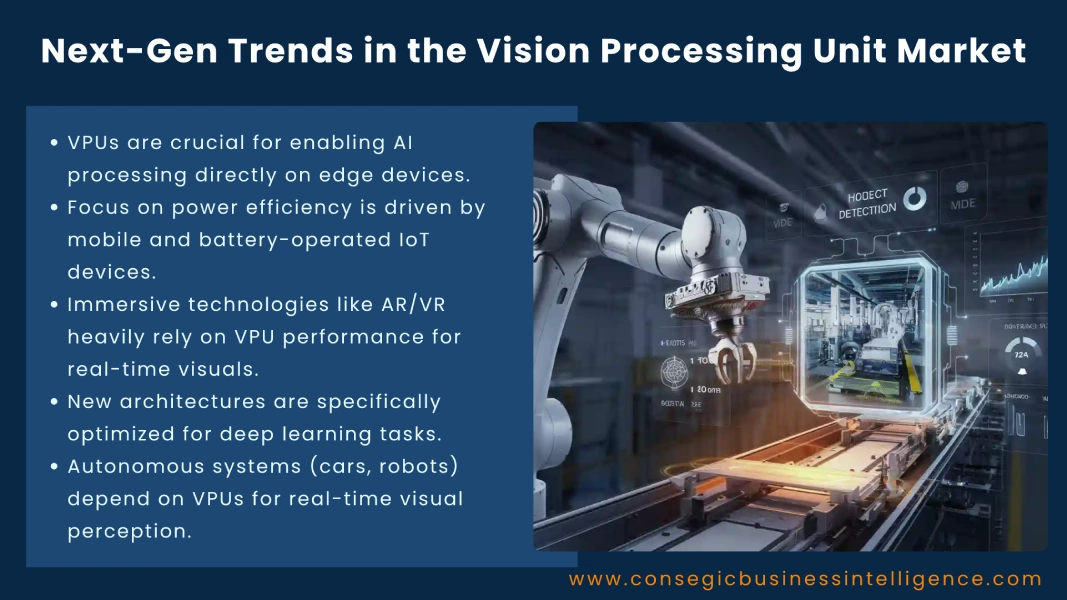Next-Gen Trends in the Vision Processing Unit Market
Vision Processing Units (VPUs) are specialized processors designed to handle complex computer vision tasks efficiently, combining high performance with low power consumption. They are critical for enabling real-time image and video analysis in applications such as autonomous vehicles, robotics, smart surveillance, AR/VR, and mobile devices. As industries increasingly rely on visual data for automation and decision-making, VPUs are becoming a central component of next-generation computing systems.

The global Vision Processing Units Market is expanding rapidly, driven by the rising demand for edge AI, energy-efficient processing, and immersive technologies. Below, we explore the top next-gen trends reshaping the VPU landscape.
- Edge AI Acceleration
One of the most significant trends in the VPU market is the shift toward edge AI. Instead of sending data to centralized cloud servers, VPUs are now enabling AI models to run directly on devices such as drones, smart cameras, and IoT systems. This reduces latency, improves privacy, and ensures real-time decision-making, which is crucial in applications like autonomous driving and industrial automation.
- Low-Power Architectures for Mobile and Wearables
Power efficiency remains a key differentiator for VPUs. Manufacturers are designing ultra-low-power architectures that deliver advanced vision processing without draining batteries. This is especially important for smartphones, AR/VR headsets, and wearable devices, where extended battery life is essential for user adoption. The trend is accelerating as consumer demand grows for lightweight, portable, and always-connected devices.
- Integration with AR and VR Platforms
VPUs are playing a pivotal role in advancing augmented and virtual reality. Real-time motion tracking, 3D mapping, and gesture recognition rely heavily on fast and efficient vision processing. As AR and VR move beyond gaming into fields like healthcare, education, and remote collaboration, VPUs are being optimized to deliver high-resolution graphics and smooth user experiences with minimal latency.
- Role in Autonomous Vehicles
Autonomous driving requires rapid processing of data from multiple sensors, including cameras, LiDAR, and radar. VPUs are central to this ecosystem, enabling object detection, lane recognition, and obstacle avoidance in real time. Next-gen VPUs are being designed with higher throughput and advanced neural processing capabilities to support the complex algorithms required for safe and reliable self-driving technology.
- Smart Surveillance and Security Applications
The demand for intelligent surveillance systems is driving innovation in VPUs. Modern security cameras now rely on embedded VPUs to process high-definition video, detect anomalies, and identify threats without relying on external servers. This trend not only reduces bandwidth needs but also strengthens data security by keeping sensitive information localized.
- Synergy with Neural Processing Units (NPUs)
VPUs are increasingly being combined with NPUs to create hybrid processors capable of handling both vision-specific and general AI workloads. This integration allows devices to run advanced deep learning models, supporting functions such as facial recognition, real-time translation, and predictive analytics. Furthermore, the convergence of VPUs and NPUs is shaping the future of intelligent devices and edge computing platforms.
- Customization for Industry-Specific Applications
Industries like healthcare, manufacturing, and retail are adopting VPUs tailored to their unique needs. For instance, in healthcare, VPUs are being optimized for medical imaging and diagnostic tools, while in retail, they enable smart checkout systems and customer analytics. This trend toward customized VPUs ensures that performance and efficiency align with sector-specific requirements.
- Evolution of 3D and Spatial Computing
The rise of spatial computing, where devices understand and interact with 3D environments is fueling demand for advanced VPUs. Next-gen units are designed to handle complex 3D vision tasks such as depth sensing, spatial mapping, and object tracking. This is critical for applications ranging from collaborative robotics to immersive AR experiences, paving the way for more interactive human-machine interfaces.
Conclusion
The Vision Processing Unit market is evolving at a rapid pace, driven by advancements in AI, edge computing, and immersive technologies. Trends such as edge AI acceleration, low-power designs, AR/VR integration, autonomous driving support, and smart surveillance highlight the growing importance of VPUs across industries. At the same time, synergy with NPUs, industry-specific customization, and the rise of 3D spatial computing are expanding the scope of these processors far beyond traditional applications.
As the reliance on real-time visual data intensifies, VPUs will remain at the core of innovation, bridging the gap between raw image capture and actionable insights. Their next-gen evolution ensures they will be critical in shaping the future of intelligent devices, smart environments, and autonomous systems worldwide.
